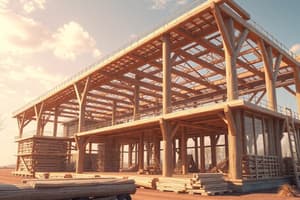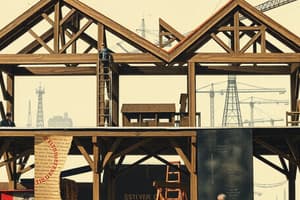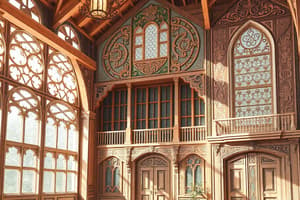Podcast
Questions and Answers
What is the distinct structure of wood that affects its use as a construction material?
What is the distinct structure of wood that affects its use as a construction material?
- Growth rings
- Mechanical testing
- Moisture content
- Anisotropic nature (correct)
Which wood product is an example of engineered wood products?
Which wood product is an example of engineered wood products?
- Laminates
- Utility poles
- Plywood (correct)
- Trusses
What type of wood has growth rings composed of earlywood and latewood?
What type of wood has growth rings composed of earlywood and latewood?
- Laminates
- Engineered wood
- Natural wood (correct)
- Strand board
What does the moisture content of a wood specimen represent?
What does the moisture content of a wood specimen represent?
What property makes wood continue to be an important civil engineering material?
What property makes wood continue to be an important civil engineering material?
What is the level of saturation at which the cell walls are completely saturated, but no free water exists in the cell cavities called?
What is the level of saturation at which the cell walls are completely saturated, but no free water exists in the cell cavities called?
What is the purpose of surfacing the rough-sawn lumber?
What is the purpose of surfacing the rough-sawn lumber?
Which type of wood is typically used for studs, joists, beams, and trusses?
Which type of wood is typically used for studs, joists, beams, and trusses?
What does the term 'engineered wood' refer to?
What does the term 'engineered wood' refer to?
What is the common shape for heavy timber according to the text?
What is the common shape for heavy timber according to the text?
Flashcards are hidden until you start studying
Study Notes
Structure of Wood
- The distinct structure of wood, composed of cellulose, hemicellulose, and lignin, affects its use as a construction material.
Wood Products
- Engineered wood products, such as plywood and laminated veneer lumber (LVL), are manufactured by combining wood fibers or layers to form a stronger and more stable product.
Types of Wood
- Softwoods, such as pine, spruce, and fir, have growth rings composed of earlywood and latewood.
Moisture Content
- The moisture content of a wood specimen represents the percentage of water present in the wood relative to its oven-dry weight.
Properties of Wood
- Wood's ability to absorb and release moisture without deteriorating makes it an important civil engineering material.
Moisture Saturation
- The level of saturation at which the cell walls are completely saturated, but no free water exists in the cell cavities, is called the fiber saturation point (FSP).
Lumber Processing
- Surfacing the rough-sawn lumber is done to improve its appearance, stability, and workability.
Lumber Usage
- Softwoods, such as spruce, pine, and fir, are typically used for studs, joists, beams, and trusses.
Engineered Wood
- Engineered wood refers to wood products manufactured by combining wood fibers or layers to form a stronger and more stable product.
Heavy Timber
- Heavy timber is commonly used in large, rectangular sections, often with a solid, rectangular cross-section.
Studying That Suits You
Use AI to generate personalized quizzes and flashcards to suit your learning preferences.



